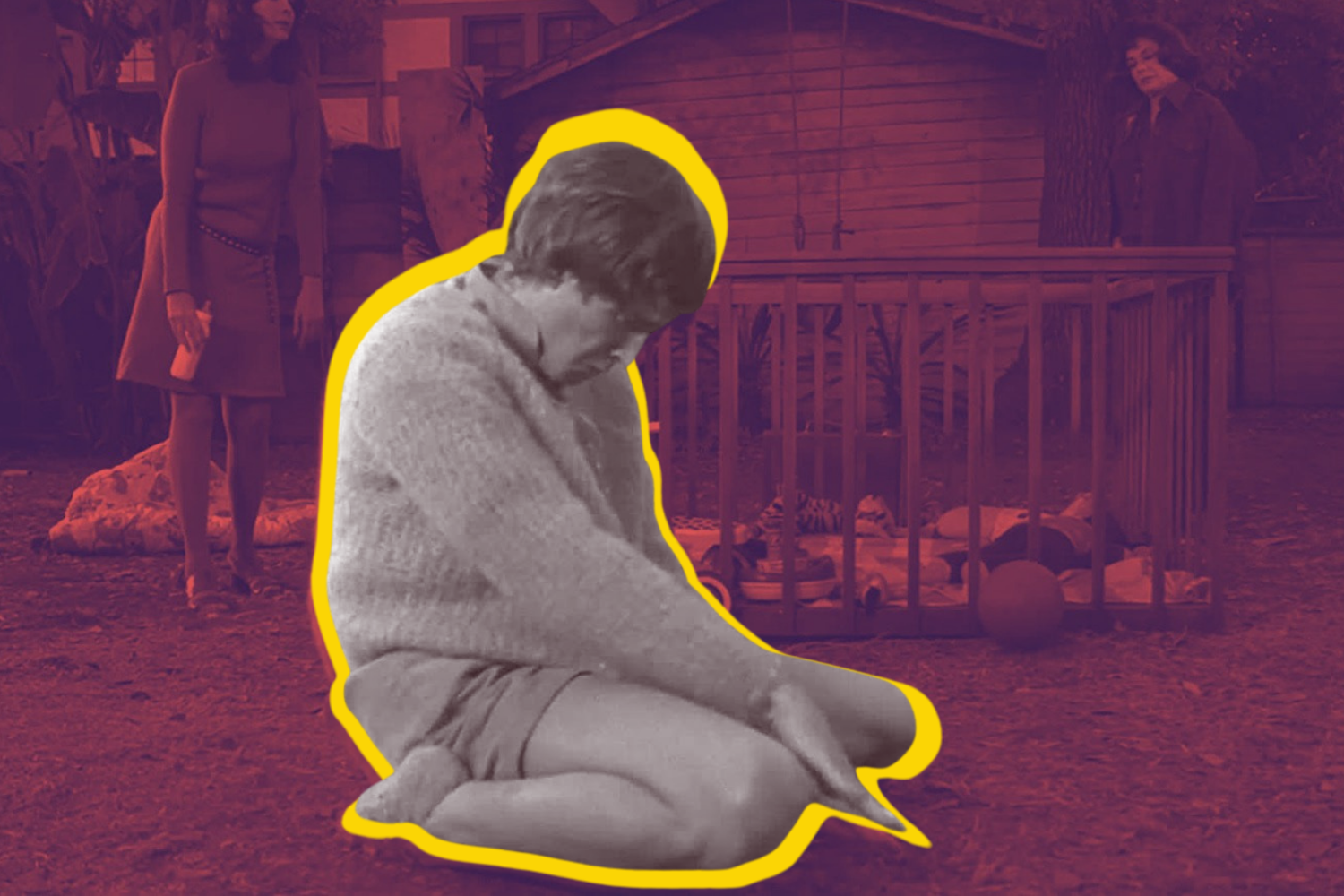Editorials
Female Rage in Ted Post’s ‘The Baby’
June 17th, 2021 | By Annette LePique

In the 2014 winter issue of Dazed Magazine, filmmaker John Waters said, “I might draw the line at adult babies—I think they’re disgusting.” Director Ted Post’s 1973 film The Baby plays on this common unease; the central baby is an adult man. However, the film crafts another, more unsettling story that lurks just below the nursery’s floorboards. An abused and nameless young man (David Manzy), known only as “Baby Wadswoth,” is forced to live as an adult baby by his mother and sisters. A lonely social worker is soon assigned to Baby’s case and appears to be his only hope for escape.
Enmeshed within Baby’s plight is the violent battle between the Wadsworth family’s women and Baby’s social worker, Ann Gentry (Annjanette Comer). Mrs. Wadsworth (Ruth Roman), Germaine (Marianna Hill), Alba (Suzanne Zenor), and Ann fight over Baby because of what he represents: identity, connection, a future. Post’s film is dominated by its women. The masks of mother, sister, and wife slip to expose a wretched psychic lack; who are they without their Baby? While The Baby presents a pervy parable on the perils of America’s empty seventies-era individualism, the film offers much to consider on contemporary narratives of faux female empowerment and victimhood. To understand the proliferation of today’s girl-boss “heroines”, we need to first understand their family of origin.
The Baby opens on Ann flipping through Baby’s social work case file. Family photographs show a diapered baby in various states of play. The photomontage continues with common scenes of infancy (the nursery, the highchair, etc.), but Baby Wadsworth continues to grow. The file ends on an image of Baby, now fully mature but wearing only a diaper and a look of extreme distress. Ann then speaks with her mother-in-law about the case. While Ann expresses purely professional interest in Baby, viewers notice her oddly hungry body language and mention of an absent husband as her driving motivation.
The film adheres to the conventions of genre cinema and maintains a twisted proximity to realism. The Baby’s slightly skewed aesthetics and off-kilter structure imbues the film’s world with a sense of everyday volatility and fragility. It is this recognition—the realization that you may have once met the Wadsworths—which locates The Baby close to the American family of the 1970s. As Christopher Lasch states in the 1979 Culture of Narcissism, “the real world is refracted in familial and personal experiences.” Political domination can then be reproduced again, and again, between individuals and within families.
From the beginning of The Baby there is the pervasive sense that something is not quite right, but this feeling is never fully identified or defined. Rather, the film works by exposing emptiness and revealing its presence in its leading women. The opening photomontage reveals Baby as an adult baby, but does not disclose how his “condition” came to pass. Baby’s image is mediated for Ann’s gaze: he is both everything and nothing, figure and shadow. This way of seeing speaks to Lasch’s understanding of how the circulation of images transformed American society in the 1970s. In Narcissism, Lasch wrote that the mechanical reproduction of images transformed modern life into “an enormous echo chamber, a hall of mirrors.”
A year prior to The Baby’s 1973 release, the Senate approved the Equal Rights Amendment. The Senate then forwarded the ERA to state legislatures for ratification, but the amendment faltered and stalled. While the ERA was meant to prohibit legal discrimination on the basis of sex, public opposition to the amendment grew throughout the 1970s. While female leaders of the opposition movement were guilty of fearmongering and spreading misinformation, these tactics spoke to increasingly broad sections of American women. This cultural turn illuminated a growing anxiety—women no longer held the same faith and surety in America’s institutions. Women were questioning who they were and who they could be amidst seismic structural change that would leave many behind.
Such transformation is why Christopher Lasch visited the White House in 1979 to advise the Carter administration on America’s growing turmoil. The country’s unchecked corporations, bloated bureaucracies, and nonexistent public life turned the communal values of the sixties to an empty and inward individualism. Lasch argued that these heightened conditions allowed for collective expression of neuroses and psychoses, with seventies era America being the land of the pathological narcissist. For Lasch, narcissists completely depend on others but resent that dependence and are defined by a “sense of inner emptiness [and] boundless repressed rage.”
Mrs. Wadsworth, Germaine, and Alba are women of their time. Mrs. Wadsworth does not have a job and depends on Germaine and Alba to support the household. Neither daughter appears deeply invested in life outside the Wadsworth home. Germaine is a sporadically employed commercial actress and Alba reluctantly teaches tennis lessons. The Wadsworth women also do not have meaningful relationships outside of their enclosed familial unit; their maternal, erotic, and sadistic drives are enacted upon Baby. The nursery is the scene of both implied incest and outright cruelty. Mother and daughters’ extreme dependence and disgust for Baby’s helplessness speaks to the narcissist’s inner emptiness, their desire for the love of others, and the rage they direct towards others for this need.
When Ann becomes Baby’s new caseworker she becomes increasingly fixated on his condition. Ann’s presence escalates the tensions within and between the Wadsworth trio. Ann begins to show up to the Wadsworth’s home unannounced and becomes obsessed with teaching Baby to talk and walk. Interspersed between Ann’s progressively erratic behavior with the Wadsworths are conversations with her mother-in-law where they appear to be mourning Ann’s husband, the older woman’s son. Ann is empty, angry, lonely, and lost; she blames herself for her husband’s mysterious accident. For Ann, Baby now represents a future and a way forward, the living embodiment of her goodness, her generosity, her capacity to give.
This is all a lie.
Ann kidnaps Baby from his birthday party to lure the Wadsworth family to her home. One by one she and her mother-in-law kill Mrs. Wadsworth, Genevieve, and Alma. Ann and her mother-in-law bury the three women under what will soon become an in-ground pool. After the murders, Ann returns to the house and heads to an upstairs bedroom to reveal a nursery inhabited by two adult babies: Baby and Ann’s presumed dead husband. The film ends as Ann plays with her two baby husbands in the pool, ecstatically happy with everything she ever wanted.
The women of The Baby are violent and abusive narcissists. They have no inner life, and such emptiness terrifies them. Every scratch or kiss given to Baby becomes a desperate gesture to find a way back to the self, to discover the self, and finally see the reflection in the mirror. Recent shows and films like Disney’s Cruella prequel, The Devil Wears Prada, and Promising Young Women tell the same stories of lost women, of female experience defined by emptiness, of limp girl-bosses marked by ego and consumption. Now is the time for The Baby to have its due. The film is a friction-filled hair pull, spit in the mouth, nail scratch of a reminder that women are neither saints nor devils. Like anyone else, we can be monsters.
Visit our Editorials page for more articles like this. Ready to support more original horror criticism? Join the Certified Forgotten Patreon community today.



